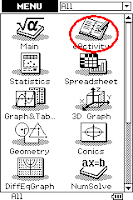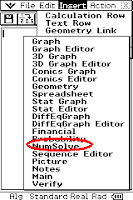Well I sat down today and finished my worked solutions for the 3A MAS course for Saddler's text. The most difficult part seems to be the Vectors component as the other areas are quite simple in their delivery.
I suggest to students to get a hold of the OT Lee text and do extra examples of these vectors questions. A couple of examination preparation books are also available from Academic associates and Academic task force. I was lucky to have been given the West One 3A CD that also has some great material to supplement the standard text.
A problem that I have seen in the class is getting students to understand the nature of vectors, especially the idea of magnitude and components. I even have to think twice when wind problems are involved. I need to amend the programme and structure it more to vectors and away from logarithms.
My advice for all starting out teachers is to do the hard yards and complete any exercises set for students before asking students to complete them. This is especially true for mature age teachers with long gaps between completing high school maths and teaching it.
One useful thing I did was mark stop points against the work where I felt I'd had enough before starting again. Although I completed the text in a couple of days, it was in multiple sittings. I'll use these stop points as indicators where I can slow the programme down.
The TDC assignments to date have been well received by students. They have been able to complete the assignments and have been positive in their feedback. If the TDC can keep supplying quality assessment then that will reduce the assessment problem for teachers starting to teach yr 11/12 specialist courses. It is daunting for starting teachers to identify good assignments/investigations.
The MAT course on the other hand so far is a bit of a doddle given the work we did with students last year.
Sunday, April 19, 2009
3A Mathematics Specialist Course
Location:Perth, WA, Australia
Perth WA, Australia
Friday, April 17, 2009
Fractions
Primary parents are always asking about ways of teaching fractions. The main thing I tell them is to spend time with their kids and work through their own thinking. One of their main concerns is that they do it differently to the teacher and don't want to get their child confused.
I relate to this as many times as teachers we have to think if we have broken it down far enough to promote thinking. Sometimes having a framework is handy with steps to teaching a concept or skill. Here's an ebook that does that (it's not perfect but it could help).
There are many other ebooks on mathematics found here
I relate to this as many times as teachers we have to think if we have broken it down far enough to promote thinking. Sometimes having a framework is handy with steps to teaching a concept or skill. Here's an ebook that does that (it's not perfect but it could help).
There are many other ebooks on mathematics found here
Location:Perth, WA, Australia
Perth WA, Australia
Monday, April 6, 2009
Happy and sad event
The guys on the Plato website today have announced that they will be winding it down stating that Platowa had achieved its objectives. I think all of us in the teaching profession in WA have a big thank you to say to these guys and what they have achieved over the last four years (especially in making the union a relevant body again). If Marko was president of the SSTUWA even a hardened anti-unionist like myself would join.
It has been amazing to watch technology used in a way that achieves an outcome, and equally amazing to see people put their jobs on the line over an ideal and principle. Agree with them or not you have to appreciate their efforts. It will be interesting to see if a lobby group like this will ever again be as powerful within the teaching fraternity (are you watching this space MAWA?).
If and when Plato is retired, I will miss reading the forum about WA education from the minds of teachers, parents and interested parties. Without it, we would not have seen into the politics of teaching. I am glad that they feel they have achieved what they set out to do. It is rare in life that we have time to reflect upon actually reaching our goals.
It has been amazing to watch technology used in a way that achieves an outcome, and equally amazing to see people put their jobs on the line over an ideal and principle. Agree with them or not you have to appreciate their efforts. It will be interesting to see if a lobby group like this will ever again be as powerful within the teaching fraternity (are you watching this space MAWA?).
If and when Plato is retired, I will miss reading the forum about WA education from the minds of teachers, parents and interested parties. Without it, we would not have seen into the politics of teaching. I am glad that they feel they have achieved what they set out to do. It is rare in life that we have time to reflect upon actually reaching our goals.
Sunday, April 5, 2009
Four days to go...
The countdown is on to the next break.. four days to go.
The last week of term is a time of wind down, with students in upper school focusing on their ball on Thursday and those in year ten disappearing on holidays before the end of term.
I'll gather in the last of the test results from this term and celebrate getting through another week eight of term. For me, week eight is always a milestone, each week eight signals getting through the goals of a term and getting that much better at teaching.
One interesting experience last week was a student that despised my teaching method last year actually sitting for two hours with me conquering a topic - at her request. Hopefully she can keep this up - it would be wonderful if she could, the re-engagement of a student into education is something that should be celebrated, too often students are lost in year 10, on the verge of starting a run at university. It signalled what we all know deep down, that a student should never be given up on, you need to be on the lookout for ways and means to repair damaged rapports.
The last week was a good one, with many signs of students understanding what senior school is all about, smiles and students seeing success in their progress.
I'm really looking forward to the break.. and some baby time. She's growing up so fast. Now that we've figured out that the expressed bottle is causing the colic.. she's another baby (and a wee bit quieter and happier!)
We reached a few milestones with the blog too, 1100 visitors this year (the same amount as the whole of last year) and over 3300 pages read. Many thanks to those that have left words of encouragement.
:-)
The last week of term is a time of wind down, with students in upper school focusing on their ball on Thursday and those in year ten disappearing on holidays before the end of term.
I'll gather in the last of the test results from this term and celebrate getting through another week eight of term. For me, week eight is always a milestone, each week eight signals getting through the goals of a term and getting that much better at teaching.
One interesting experience last week was a student that despised my teaching method last year actually sitting for two hours with me conquering a topic - at her request. Hopefully she can keep this up - it would be wonderful if she could, the re-engagement of a student into education is something that should be celebrated, too often students are lost in year 10, on the verge of starting a run at university. It signalled what we all know deep down, that a student should never be given up on, you need to be on the lookout for ways and means to repair damaged rapports.
The last week was a good one, with many signs of students understanding what senior school is all about, smiles and students seeing success in their progress.
I'm really looking forward to the break.. and some baby time. She's growing up so fast. Now that we've figured out that the expressed bottle is causing the colic.. she's another baby (and a wee bit quieter and happier!)
We reached a few milestones with the blog too, 1100 visitors this year (the same amount as the whole of last year) and over 3300 pages read. Many thanks to those that have left words of encouragement.
:-)
Saturday, April 4, 2009
Three steps forward...
There are times when I wonder, 'what have we been doing for the last two weeks?' My year tens are at this stage right now. We've been going through linear algebra for two weeks and it's clearly beyond a good dose of my students.
There are a number of issues:
a) They have weak self esteem and give up before trying
b) They have a low work ethic
c) Their algebra skills are weak-non existent (transposing to find c in y=mx+c is heartbreaking)
d) Their operations are weak (explaining gradient in terms of rise/run leads to all sorts of issues)
e) Their understanding of negative numbers is suspect
So I have two choices, teach them the topic and hope that the students get something from it to help them on their next iteration of learning or try and fill the gaps that 9 teachers before me have tried to fill with limited success.
Current thinking would say cater to individual differences and backtrack. I'm not sure that this is the right thing to do. By teaching the topic it gives the students an opportunity to 'get the gist' of what is being achieved (associate linear algebra with lines and equations, learn about gradient and slope, be able to find the y intercept and the like) and then hope that when they do 1B or 2A next year they can use this knowledge to properly participate in class.
I don't know.
There are a number of issues:
a) They have weak self esteem and give up before trying
b) They have a low work ethic
c) Their algebra skills are weak-non existent (transposing to find c in y=mx+c is heartbreaking)
d) Their operations are weak (explaining gradient in terms of rise/run leads to all sorts of issues)
e) Their understanding of negative numbers is suspect
So I have two choices, teach them the topic and hope that the students get something from it to help them on their next iteration of learning or try and fill the gaps that 9 teachers before me have tried to fill with limited success.
Current thinking would say cater to individual differences and backtrack. I'm not sure that this is the right thing to do. By teaching the topic it gives the students an opportunity to 'get the gist' of what is being achieved (associate linear algebra with lines and equations, learn about gradient and slope, be able to find the y intercept and the like) and then hope that when they do 1B or 2A next year they can use this knowledge to properly participate in class.
I don't know.
Wednesday, April 1, 2009
Ten Tips for Practicum Students
I remember being on practicum and had my collection of nightmares and successes. After recently having a practicum student, it reminded me of some of the things I learnt while on practicum. There are lots of things that you are told at uni, but here are some of the more obvious that you may not be told.
1. If you are going to talk to the class, ensure that all students are ready to listen. Don't talk until you have full attention of everyone in the class. Create a spot at the front of the class so that students know that you are waiting to start.
2. Don't talk to the board while writing on it. There aren't any students behind it to hear you.
3. If your practicum teacher tells you to do something, do it. Write it down so you don't forget.
4. Appreciate your practicum teacher. The $12.50 per week and the aftermath is not worth it. They are doing it for the right reasons.
5. Don't have another job outside of school whilst on practicum. You are making a hard job harder.
6. Don't get lazy or cocky.. when you think you are prepared, prepare a little more.
7. Make sure students have been taught enough to complete any task you set them.
8. Do any exercise/task yourself first before you give it to students.
9. Have a clear introduction and conclusion to your lesson (keep an eye on your timing!).
10. Take praise and criticism well from students and peers. Reflect, learn from mistakes and grow thick skin where required.
11. Be rested, eat well and look after yourself.
Ok, it was eleven.. shoot me.
:-)
1. If you are going to talk to the class, ensure that all students are ready to listen. Don't talk until you have full attention of everyone in the class. Create a spot at the front of the class so that students know that you are waiting to start.
2. Don't talk to the board while writing on it. There aren't any students behind it to hear you.
3. If your practicum teacher tells you to do something, do it. Write it down so you don't forget.
4. Appreciate your practicum teacher. The $12.50 per week and the aftermath is not worth it. They are doing it for the right reasons.
5. Don't have another job outside of school whilst on practicum. You are making a hard job harder.
6. Don't get lazy or cocky.. when you think you are prepared, prepare a little more.
7. Make sure students have been taught enough to complete any task you set them.
8. Do any exercise/task yourself first before you give it to students.
9. Have a clear introduction and conclusion to your lesson (keep an eye on your timing!).
10. Take praise and criticism well from students and peers. Reflect, learn from mistakes and grow thick skin where required.
11. Be rested, eat well and look after yourself.
Ok, it was eleven.. shoot me.
:-)
Sunday, March 29, 2009
Variables on the classpad
There has been some confusion about how to define variables on the classpad in my class. Here is what we have discovered.
If we use a variable found under the mth tab -> var on the soft keyboard (the variables that are italicised) it is treated as a normal pronumeral in algebraic equations (multiplication is assumed with adjacent pronumerals). The x,y,z on the keypad is also treated this way.
eg x = 10, y=20; therefore xy=200
The multiplication sign is automatically added.
If we name a variable using the abc tab in the soft keyboard(the variables that are not italicised) then we are naming a variable that has multiple letters.
eg xy =10; x & y are undefined.
m = rise ÷ run
Potential Gotcha!
We have to be careful not to confuse functions defined under the mth tab (eg. trig ratios) and variables that we have created when using NumSolve. One of my students entered this on their calculator.
Cosθ=adj÷hyp
It would return the fractional value adj÷hyp rather than the value for theta. This is because the student had defined a variable "Cosθ" by typing Cos via the soft keyboard rather than entering the function Cos via mth->trig->Cos.
Superscripts and Subscripts
Later on students will want to use subscripted characters when creating variable names. One example is the gradient formula.
m=(Y2-Y1)÷(X2-X1)
The subscripts are found in the soft keyboard under abc->math at the bottom of the screen. Superscripts are on the line above it. Only numbers at this stage (more will be possible as more fonts are released) can be superscripted or subscripted as far as I can see.
Here is a link to other CAS calculator posts.
If we use a variable found under the mth tab -> var on the soft keyboard (the variables that are italicised) it is treated as a normal pronumeral in algebraic equations (multiplication is assumed with adjacent pronumerals). The x,y,z on the keypad is also treated this way.
eg x = 10, y=20; therefore xy=200
The multiplication sign is automatically added.
If we name a variable using the abc tab in the soft keyboard(the variables that are not italicised) then we are naming a variable that has multiple letters.
eg xy =10; x & y are undefined.
m = rise ÷ run
Potential Gotcha!
We have to be careful not to confuse functions defined under the mth tab (eg. trig ratios) and variables that we have created when using NumSolve. One of my students entered this on their calculator.
Cosθ=adj÷hyp
It would return the fractional value adj÷hyp rather than the value for theta. This is because the student had defined a variable "Cosθ" by typing Cos via the soft keyboard rather than entering the function Cos via mth->trig->Cos.
Superscripts and Subscripts
Later on students will want to use subscripted characters when creating variable names. One example is the gradient formula.
m=(Y2-Y1)÷(X2-X1)
The subscripts are found in the soft keyboard under abc->math at the bottom of the screen. Superscripts are on the line above it. Only numbers at this stage (more will be possible as more fonts are released) can be superscripted or subscripted as far as I can see.
Here is a link to other CAS calculator posts.
Location:Perth, WA, Australia
Perth WA, Australia
Saturday, March 21, 2009
Trigonometric equations and the CAS calculator
There are lots of ways of solving trigonometric equations on the Classpad but I have avoided using Trisolve as it takes away the thinking aspect of trigonometric equations. Instead I focussed on setting up equations in eActivities with the intent to complement them with the Geometry section later.
eActivities are a great place to store frequently used equations. In this instance, I wanted to keep all of the trigonometric and circle equations in one place ie sine, cosine & tan ratios, sine rule, cosine rule, sector, segment equations, circumference, area.

Then I started a new eActivity by going File -> New. Then I saved it by going File->Save. I called it Trig Formulae.


Once the strip was added I used the soft keyboard to name it the Sine ratio. Then I pressed solve to put the equation in.

eActivities are a great place to store frequently used equations. In this instance, I wanted to keep all of the trigonometric and circle equations in one place ie sine, cosine & tan ratios, sine rule, cosine rule, sector, segment equations, circumference, area.
To do this I opened an eActivity from the main menu.

Then I started a new eActivity by going File -> New. Then I saved it by going File->Save. I called it Trig Formulae.


Once the strip was added I used the soft keyboard to name it the Sine ratio. Then I pressed solve to put the equation in.

Using the mth tab in the soft keyboard and then selecting the Trig option at the base of the soft keyboard I entered 'sin('. Directly below the mth tab, the theta button can be found and then closed the bracket. Don't type the word 's' 'i' 'n' using the soft keyboard as it won't work - it will treat it as s x i x n.
Then using the 2D tab, I created a fraction and using the var option entered o ÷ h. I hit exe, then closed the equation using the x at the top left hand corner of the window.
I then tried it out using the example opp=7, hyp=14, theta = ? I left theta blank, made sure the angle was selected (with the dot next to it coloured in) and pressed solve in the toolbar. Viola, theta = 30°. If you get some weird answers check that the calculator is set in degrees mode. If the answer is still weird, reset the calculator and it seems to work.
Update (25/3/09): After using this with the class for a few days (especially with radians) I noticed a few strange results where the calculator would return unexpected answers (eg for the above example -330°). To fix this, set the Lower bound to 0 and the upper bound to 180 (for degrees) or pi/3.14159 (for radians) and the results will appear as expected.
I then set about putting in the cosine ratio.
It's a great tool for things like the cosine rule where students find it hard to transpose equations and forget negative signs or for circle, segment and sector equations that are commonly forgotten.
Here is a link to other CAS calculator posts.
Subscribe to:
Comments (Atom)





